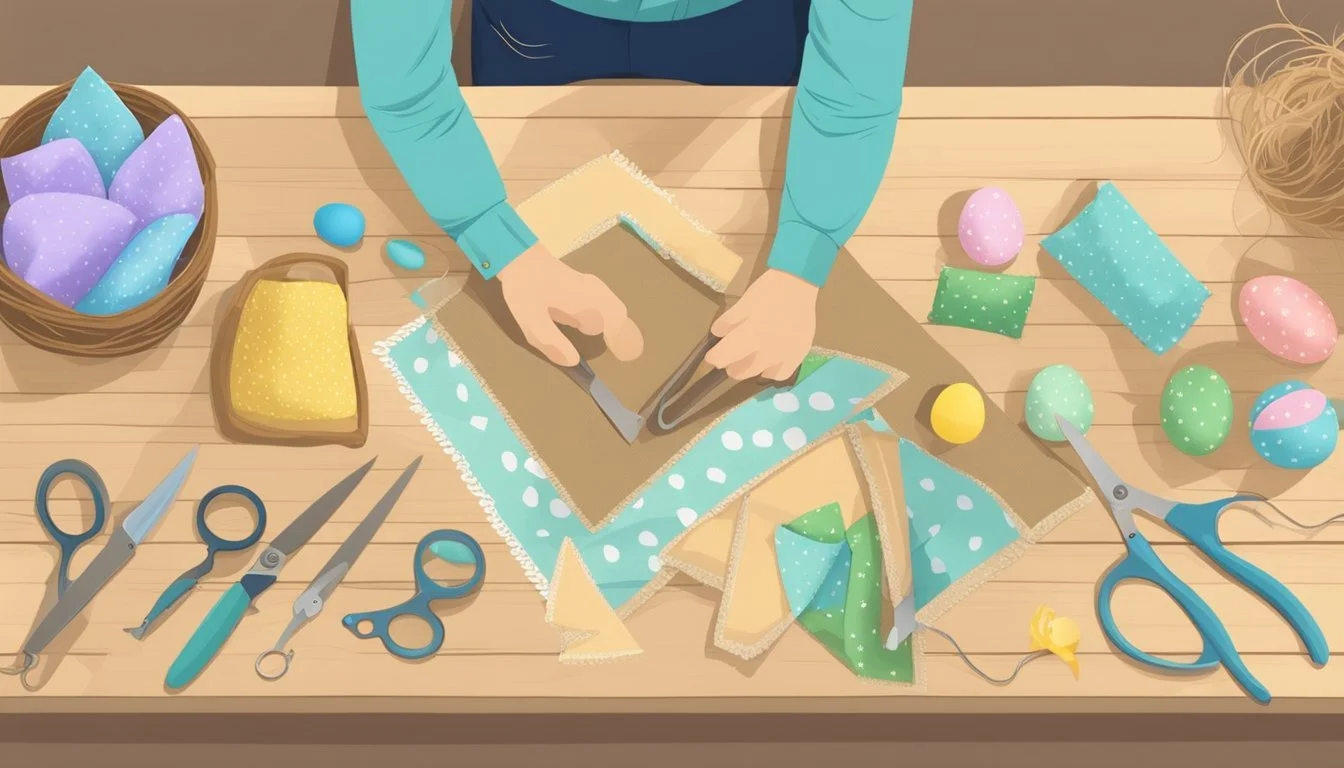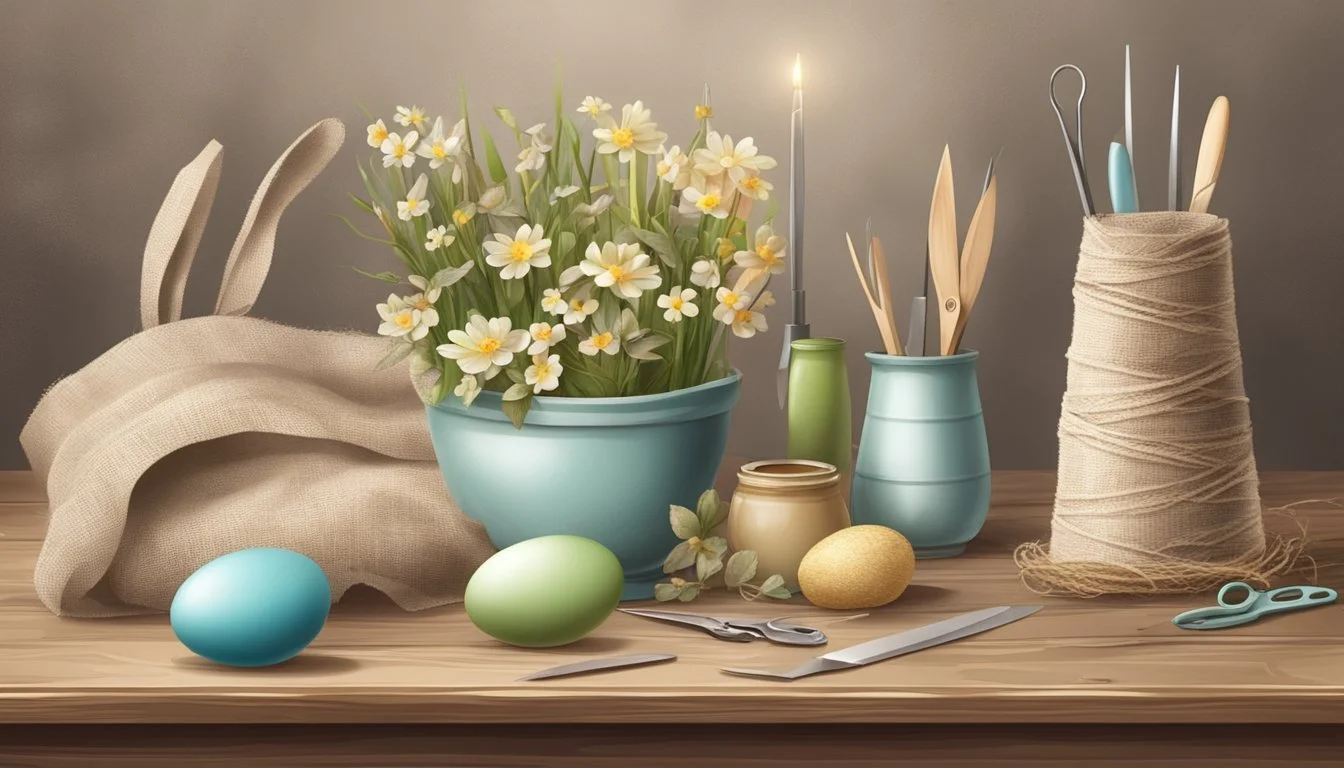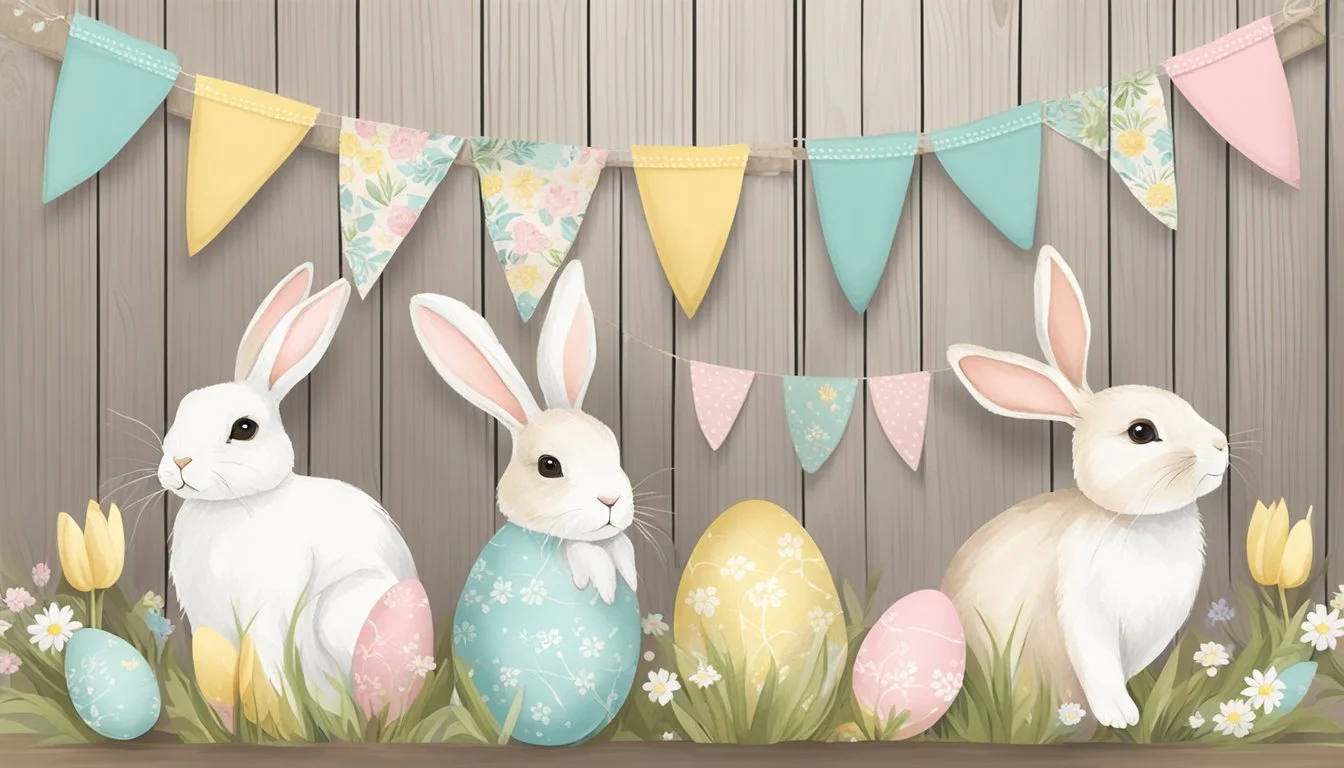Rustic Easter Bunting
Elegant Fabric and Burlap Decor Ideas
Easter celebrations often evoke a sense of renewal and joy, marking a period where the warmth of spring encourages gatherings and festive decorations. Rustic Easter bunting, which encompasses the use of natural materials like fabric and burlap, creates an inviting and homey charm that suits this holiday perfectly. These decorations can reflect the season's change as they blend seamlessly with the blooming backdrop of spring.
Utilizing burlap in crafting Easter bunting is a nod to country aesthetics, where the material's earthy texture complements the fresh pastel palettes commonly associated with Easter décor. The fabric's durability also makes it a practical choice for both indoor and outdoor settings, enhancing the festive atmosphere of garden parties, country-themed weddings, or farmers' markets.
In addition to its functional benefits, burlap offers an element of effortless craftiness that encourages DIY enthusiasts to personalize their holiday decor. Simple fabric shapes, such as eggs or bunnies, can be sewn onto triangular burlap flags to evoke the Easter spirit. Whether strung across a mantel or draped along a fence, rustic Easter bunting fashioned from fabric and burlap can serve as a focal point in the seasonal adornment of any space.
Understanding Rustic Easter Decor
Rustic Easter decor is characterized by its natural, earthy elements and casual charm. Burlap is a favorite material for this style, offering a rough texture that embodies the simplicity and ruggedness of rustic design. It's often paired with lace to balance its coarseness with a touch of elegance, creating a visually appealing contrast.
The use of flowers plays a pivotal role in rustic Easter decor, as they bring a splash of color and life to the setting. Whether used fresh or as dried arrangements, flowers complement the earthy tones of burlap and wood, enhancing the overall aesthetic.
Wooden crates are another staple in rustic decoration. They serve both as containers for displaying decor and as stands to elevate ornaments for better visibility. Their natural wood grain adds a depth of character that resonates with the rustic theme.
The rustic theme may also blend with a shabby chic approach, which embraces the beauty of items with a weathered and well-loved appearance. Shabby chic contributes to the homely and welcoming atmosphere commonly sought in Easter celebrations.
Key materials: Burlap, Wood, Lace
Decor elements:
Burlap bunting with lace trimmings
Wooden crates filled with Easter eggs
Mason jars adorned with ribbons and flowers
Vintage signs and symbols of Easter
In sum, this style of decor taps into the joy of Easter while staying true to a design that's approachable and grounded in simplicity. It's the perfect backdrop for celebrating a holiday that's synonymous with renewal and nature's beauty.
Materials and Tools Required
For the creation of rustic Easter bunting, it is essential to select the right materials that will give a cozy, countrified feel to your decorations. The tools required are equally important, as they will ensure a smooth crafting process and a high-quality finished product.
Choosing Fabrics and Materials
The base fabric for rustic Easter bunting commonly involves burlap due to its natural, earthy texture that complements outdoor or country-themed events perfectly. In addition to burlap, one might consider adding cotton fabrics in pastel colors or with Easter-themed prints such as flowers, bunnies, and eggs. Combining burlap with fabrics like lace or ribbon can add a touch of elegance to your bunting.
Essential Crafting Tools
Crafting rustic Easter bunting requires a set of basic tools:
Scissors or pinking shears: Pinking shears help prevent fabric fraying.
Sewing machine (optional): For those who prefer sewn bunting, although burlap can be sewn by hand if desired.
Iron: Essential to smooth out the fabrics for a neater appearance.
Templates or stencils: These aid in creating uniform shapes for the bunting flags.
Glue or hot glue gun: To adhere decorative elements without sewing.
Decorative Elements
Decorative accents can transform simple bunting into festive Easter decor. Here are some elements one could incorporate:
Twine: For stringing together bunting flags, jute twine works well with the rustic theme.
Synthetic bunny tails, twigs, or moss: These can be affixed to the bunting for a three-dimensional effect.
Artificial nest or Easter-themed cut-outs: Enhance the visual interest of your bunting with these seasonal decorations.
By gathering these materials and tools, one is well on their way to creating unique and charming Easter bunting that adds a rustic touch to any springtime celebration.
Creating the Base for Bunting
To ensure the success of your rustic Easter bunting, start by preparing the base correctly. Careful cutting and assembling of fabric and burlap triangles, alongside a choice to sew or use adhesive, lay the foundation for your decorative piece.
Cutting Fabric and Burlap Triangles
For your fabric bunting, select a variety of cotton fabrics and burlap that complement the Easter theme. Using pinking shears, cut the fabric and burlap into triangles. The shears will help prevent fraying and add a decorative edge. Aim for a consistent size, typically around 8 inches tall by 6 inches wide for visual harmony.
To cut triangles:
Measure and mark your fabric and burlap.
Cut with pinking shears to create zigzag edges.
Sewing or Gluing Pennants
Once your triangles are cut, you may choose to sew or glue them to create pennants. Sewing with a sewing machine provides durability, while using fabric glue is a quicker alternative that doesn't require sewing skills.
To assemble pennants:
If sewing, use a simple straight stitch along the sides of the triangle, leaving the top edge open.
If gluing, apply a thin line of glue along the edges, pressing firmly to secure.
Adding Rustic Charm
Incorporating rustic elements like lace, jute twine, or ribbon adds texture and charm to your bunting. Attach bias binding, ribbon, or lace across the top of your pennants to string them together. For Easter, consider intertwining pastel-colored ribbons or using burlap for an earthy feel.
To add charm:
Paint designs on burlap triangles, such as nests or bunny silhouettes.
Alternate between fabric and painted burlap pennants for a varied look.
Decorating and Personalizing Bunting
Bunting is not only a functional piece of holiday decor, but also a canvas for expressing creativity and seasonal cheer. This section explores how bunting can be decorated and personalized with a rustic Easter theme using elements from nature and festive accents.
Incorporating Nature-Inspired Accents
To reflect the essence of spring and the rustic theme, one can integrate nature-inspired accents into their bunting design. Adding twigs or moss can give the bunting a woodland feel. Tuck small nests among the folds or attach them to the string with a hot glue gun. Each nest can cradle miniature Easter eggs for an added touch of festivity. Additionally, sprigs of flowers or tufts of burlap reminiscent of bunny tails infuse your decorations with the warmth and freshness of the season.
Materials:
Twigs
Moss
Miniature nests
Small craft Easter eggs
Burlap pieces
Fresh or faux spring flowers
Easter-Themed Embellishments
Tailor the bunting to the Easter holiday by incorporating Easter-themed embellishments. Use stencils and craft paint to stencil bunny silhouettes or egg shapes onto triangular bunting flags made of fabric or burlap. Ribbon and lace can be added as border details or as loops at the edge of each flag to introduce a soft, delicate texture. If working with fabric, consider using pastel colors that embody the palette of the holiday.
Easter Elements:
Bunny silhouettes
Egg shapes
Pastel-colored ribbons and lace
Customization and Detailing
The personal touch is what makes handcrafted bunting unique. Customization can be as simple as painting initials onto eggs or as elaborate as hand-sewing lace around the edges of each flag. Crafting details like attaching small pom-poms to represent bunny tails on the back of burlap rabbits, or weaving thin ribbons through the top edge of the bunting, can elevate your Easter decoration.
Personal Touches:
Painted initials on fabric or burlap eggs
Lace edging on flags
Pom-pom bunny tails
Woven ribbon on bunting edge
Display Tips and Ideas
When incorporating rustic bunting into your decor, focus on materials like burlap for a textured, earthy feel, and emphasize seasonality in the designs for an authentic touch.
Arranging Bunting Around the Home
For indoor decorations, burlap bunting can be draped across the mantel in the living room to create a warm, inviting space. The natural color of burlap complements the rich wood tones typically found in this central area. To enhance the look, consider flanking the bunting with spring wreaths or Easter-themed centerpieces. Displaying the bunting along the edges of shelves integrates the aesthetic seamlessly, especially when combined with other rustic elements like a wood crate or arranged next to picture frames.
Beyond the Home: Outdoor Spaces
Burlap bunting is also well-suited for the outdoors, especially during seasonal weddings or Easter gatherings. String the bunting along fences or porch railings to invoke a festive aura. For outdoor dining, a table runner made from burlap enhances a rustic table setting, especially when adorned with seasonal flowers or greenery.
Occasion-Specific Designs
The fabric and burlap combination is versatile for various holidays and occasions. For a personalized touch at weddings, bunting with the couple's initials or in wedding colors can adorn the ceremonial arch or the reception area. During Easter, bunting featuring fabric eggs or bunnies adds thematic charm, while for a birthday, numbers or letters on the bunting can spotlight the celebrant's age or name. Tailor the burlap bunting's accents—such as lace or ribbon—to align with the particular occasion, ensuring it melds effortlessly with the overall decor theme.
Care and Storage of Rustic Bunting
When storing rustic bunting made of fabric and burlap, one must ensure the material is clean and completely dry. Burlap, being a coarse and natural fiber, is prone to mildew if stored damp. It’s recommended to first spot-clean any areas that may have become soiled during use. For fabric bunting, following washing instructions on the tag is crucial to maintain colors and fabric integrity.
Ironing prior to storage is useful for both aesthetics and preservation. Burlap can be ironed on a high setting with steam to eliminate wrinkles, while fabric bunting may require a lower heat setting to prevent damage. They should be ironed flat to ensure they hang neatly the next time they are used.
For the storage process, consider these steps:
Fold or Roll: Gently fold fabric bunting or roll to prevent creases. Burlap can be rolled around a cardboard tube to maintain shape and avoid creasing.
Breathable Container: Store in a breathable container like a cotton bag or a cardboard box. Avoid plastic, as it can trap moisture.
Label: Clearly label the storage container to make it easier to find your decorations when needed.
Avoid Weight: Store containers in a dry place and ensure they are not placed under heavy items that could compress and damage the bunting.
Check Periodically: If bunting is stored for a long duration, periodically inspect it for any signs of damage or mustiness and to ensure it remains in good condition.
By following these guidelines, rustic bunting will remain an enduring and charming addition to the seasonal decorations.
Crafting as a Hobby or Business
Crafting rustic Easter bunting can be a fulfilling hobby, but it also offers an opportunity to create a business. Selling handmade items on platforms like Etsy allows crafters to share their unique gift ideas with a wider audience. Building a supportive crafting community enhances the experience and helps navigate the distinct challenges of online retail.
Selling Handmade Bunting on Etsy
Etsy is a premier online marketplace for selling handmade goods, including fabric and burlap bunting. Crafters can set up their own shop, list products, and reach customers seeking unique decorations. Key steps to begin selling on Etsy include:
Creating a Shop: Register for an account, choose a shop name, and set up shop preferences.
Listing Items: Post bunting products with clear descriptions, high-quality images, and set competitive prices.
Customer Interaction: Respond promptly to inquiries and gather email addresses for future newsletters and exclusive offers.
Marketing: Utilize Etsy’s promotional tools and social media to drive traffic to listings.
Building a Crafting Community
Building a community around crafting can enhance both hobby and business aspects. Crafters can:
Engage with followers through social media and crafting blogs.
Offer crafting subscriptions for regular delivery of new and exclusive bunting designs.
Organize local crafting workshops or collaborate with fellow Etsy sellers to host virtual crafting events.
Navigating Online Retail Challenges
Online retail comes with its own set of challenges, which include but are not limited to:
Technical Difficulties: Customers may face issues with CAPTCHA, ad blockers, or browser incompatibilities during shopping.
Visibility: Standing out in a crowded marketplace requires strategic use of keywords and SEO practices.
Shipping and Returns: Develop clear policies on shipping, returns, and handling customer expectations.
By addressing these challenges with a strategic approach, crafters can establish a successful online business, turning their passion for crafting into a profitable enterprise.
Conclusion
Rustic Easter bunting is a charming addition to spring holiday decor, providing a warm and homely ambiance. The combination of burlap and fabric allows for a plethora of creative possibilities, fitting various aesthetics from country to shabby chic. Crafting such decorations not only personalizes a space but also offers the satisfaction of DIY creativity.
They can easily incorporate this decor into indoor settings, such as over mantlepieces, or in outdoor spaces, wrapped around railings or strung between trees. For a cohesive look throughout their home or event, they might consider coordinating the bunting design with other Easter decorations.
Here are some key points to remember:
-Burlap: Offers durability and a rustic texture. Ideal for outdoor use. -Fabric: Adds color and can complement various themes with a choice of prints. -Crafting: Involves simple techniques that require minimal tools, making these projects accessible to crafters at any skill level.
This style of decoration encapsulates the essence of a rustic Easter celebration, infusing the environment with a sense of warmth and seasonal charm. Whether they are an avid crafter or a beginner, creating rustic Easter bunting can be an enjoyable and rewarding experience. With a touch of creativity, they can transform simple materials into a captivating display that enhances their Easter festivities.





